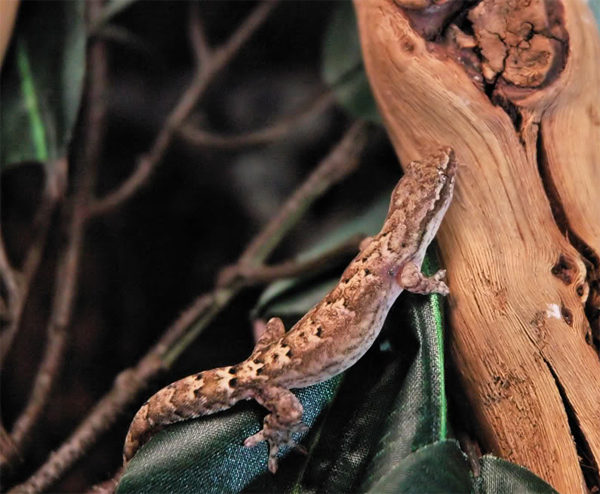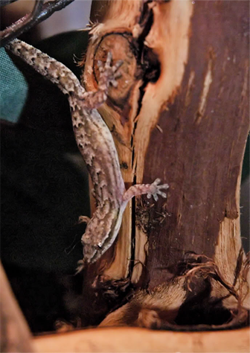Mourning Geckos are small, parthenogenic, colony geckos. They are very active, have social hierarchies and very distinct body language and vocalizations.
These geckos are rumored to have received their common name from the natives of their home range hearing the calls and believing that they were mourning their lost male mates. Being parthenogenic, the females essentially clone themselves when they lay eggs. So be aware that if you purchase any you will get babies.
The most important thing with this species is ESCAPE PROOF CAGES. They are very small; as adults they are about 3-4 inches long and very slender, so if there are cord holes or if the mesh has wide holes they can escape. We found out that our plugs had come out of the holes when we saw mourning geckos on our walls. You can plug the cord holes in the back of the Exo Terra tanks by using damp paper towels and letting them dry in the hole or covering the holes up with something like Great Stuff.
[ad#sponsor]
Housing and humidity
These are colony lizards so please purchase more than one unless you already have some at home. They interact, are very social with each other, have body language and vocalizations that make them very delightful animals to observe and learn about. Even though they are small you want to give them room to move as they are very energetic creatures. We have 7 adults in an 18x18x24 Exo Terra Tank. You can put 3 or 4 in the 12x12x18 Exo Terra or something of similar dimensions. They are arboreal and need little places to hide. They are nocturnal, though in captivity they can be more active during they day than they would be in the wild. They like lots of places to hide and run about on so please provide plenty of trees with hollows, holes and plants. They will squabble over prime spots so the more spots to hang out on the better.
We mist our enclosures about 3 times a day as we are in AZ; they prefer it humid. We keep ours around 60-70%.

Food
We give ours hydei fruit flies, small crickets, phoenix worms, mealwoms (smaller ones) and baby roaches and we have found out that they like the Crested Gecko Diet. We put a cap full in the tank along with a water dish and they will go drink the CGD on their own accord. We also dust our insects every third feeding with Repcal (phosphorous free) and once a week with Reptivite ( a multivitamin powder for reptiles). We feed them daily as they have very high metabolisms. They get live insects 4 times a week and Crested Gecko Diet is always in the tank. If they are not fed well they will eat their eggs and hatchlings. You can also leave cuttle bone or a cap of pure calcium (phosphorous free), that has no D3, and they will self regulate their calcium intake.
Handling
You can handle mourning geckos but you have to be VERY gentle. They are small and their skin will tear if handled too roughly. The best advice to start out with is to handle them in their tank until you get used to how fast and delicate they are. That way if one jumps you won’t be chasing it across the floor. They can become rather tame, but it takes patience to get them to this point.

Temperature and Substrate
Temperature should be above 70 degrees but no more than 85 degrees and the substrate should be something along the lines of Repti Bed, Peat moss and coco fiber, etc. You want something that retains moisture well.
Quirks

These geckos will eat their eggs from time to time and hatchlings if given the chance, so when your gecko lays eggs do not panic if you see them eating an egg. However watch for hatchlings after about 60 days and remove hatchlings as soon as you see them. They will start laying eggs around 8-10 months old. The geckos stick their hard shelled eggs to the side of the tank. We do not remove them as we have noticed that once the females all got on the same cycle of laying eggs they stopped eating the eggs as often. Plus they usually lay the eggs in the hardest spots to get to, any spot they feel makes a secure nesting site.
The most common noise mourning geckos make sounds exactly like a baby chick peeping. They also make a squeaking sound similar to a mouse. A mourning gecko will use its tail to communicate, waving it around, arcing over its back, shaking it side to side and more. Some more dominant animals will try to loom and make themselves seem larger and often make mock charges at subordinate, less dominant geckos.
I find these tiny geckos to be amazing and wonderful pets. Watching the colony interact is fascinating, these adorable little geckos are a true joy to own.
[ad#300]


Thank you for sharing this.
Do this gecko egg come in pair like tokay gecko egg?
In Malaysia, this species is called “tokek batu” or am I mistaken it with other gecko. Tokek Batu (Batu=stone) get its name because they like to live in rock environment. can we put rock in the aquarium?
Love the Mourning Gecko article! Not much info on these wonderful geckos out there.
Thanks aton this article helped alot these are great geckos!
Thank you for the article. Just found it when I was looking for information. Just saw two eggs in my terraruim.
I am planning to get one L. lugubris, and then leave it to make a colony. The geckos are better described with the word scansorial, as they aren’t adapted for life specifically on trees, like cresteds for example. They can live also on rocks and in buildings. In the site of a German called Binary Nature, who has a lot of experience with keeping and breeding those animals, he says that cannibalism is in fact quite rare. Adults usually vocalize towards their own young, and rarely eat them due to food scarsity or by mistaking them for food. Also smaller ones come out during the day more often. What does that mean, that they need uv? Is supplementation d3 necessary otherwise?
Hi! I have two juveniles that I’m going to introduce into an exo terra as adults to start a colony.
Can newborns fit through the gap between the doors and sideglass?
I haven’t kept mourning geckos, but I have had P. klemmeri and am now keeping Sphaerodactylus. The P. klemmeri did get out when I first kept her as a juvie. Here’s what I recommend:
–Ideally you should remove the background. If you don’t want to do that, take wet paper towel and stuff it in the crack between the top of the background and the top of the enclosure.
–make sure the sliding tab at the top of the enclosure that can be open or closed (it can open to make it possible to pass cables down behind the background) is closed
–close the doors and check out the gap. Get clear packing tape and build it up to the point where there is no longer a gap.
When I first got my sphaerodactylus, one was so small, it had gotten through the holes in the deli cup in the packing box. It was never able to get out of the exo-terra since I had built up the places where the gaps are.
Thanks!!! I know klemmeri are laterally thin making them great escape artists, i will however do as suggested.
It’s a good solution and you can never be to safe
Cheers!
When I got home from Hawaii I found one in my sleeping bag. It’s been over a year an now I have at least 5 maybe more. Mine was white when I got home from Hawaii so I thought they are like anoles an change two colors. Am I right just wondering. An thanks for your site it is so helpful. I wish I found it earlier.
I’m not familiar with the species, though the author of the article may respond. As far as color change, most geckos that change color are either shedding, in which case they look frosty white, or have a fired up/fired down cycle like crested geckos and gargoyle geckos.
Where we were staying for the last few days there were white geckos on the walls everywhere. I may have a picture. I can send you if I can.
It is common for these geckos to adjust shade and pattern to some degree based on temp and stress levels. There are also several strains of mourning geckos that have different patterns and colors.
I have 3 mourning geckos this year so hopefully some eggs before year end. To prevent them from escaping from their exo terra viv, Ive fitted some insect mesh across the inside of the front and fixed it in place with 2 slide binders so there is no gap when the glass doors are opened and I cut a flap in the mesh to get into the viv to add bugs, change water and food and tidy up. works brilliantly, no escapes so far, gecko or bug!